Carlingford Wildlife Page
Bird Watching in Spring/Summer around The Cooley Peninsula and Carlingford
Carlingford and environs are an ideal place to watch birds, both for beginners and for experts. The combination of habitats include
- wide area of mudflat and sand-flat in Carlingford Bay
- the Lough's estuarine character
- beaches of both shingle and sand to the south
- mountain and woods in the surrounding countryside
- hedgerows, reed beds, marsh, streams and small ponds along the shore
April is the month when many of the winter species leave for their breeding grounds further north and summer species arrive to breed here in Ireland. The arrival of swallows and terns is the signal of the start of spring. The accompanying chorus of songbirds and hopefully sunny weather makes for a different birding experience to winter.
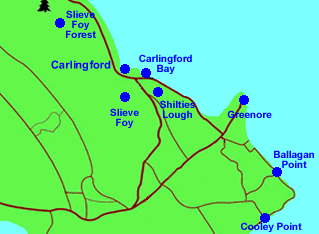
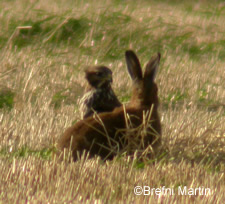
Buzzard &
hare willville sept 05
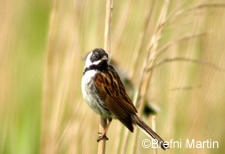
Reed bunting
high wind balaggan may 05
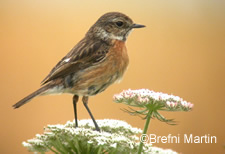
Stonechat, whitestown aug 05
A good place to start is Carlingford village itself. From the end of April you will see a flock of Swifts screaming around the village at high speed. They are all black with a small whitish patch under the bill. Swifts migrate from sub-Saharan Africa along with the three similar hirundine species: swallows, house martins and sand martins. Swallows and House martins may be seen in the fields and nesting in the houses around Carlingford. Swallows and House Martins make nests under the eves of buildings while you have to go further afield to see sand martins.
Walking from the village around the harbour and along the hard shoulder towards Greenore you will see many seabirds depending on the state of the tide.
Firstly there is usually a scattering of waders including, Dunlin Turnstone (in rich summer plumage), Ringed Plover, Oystercatcher, Redshank, Heron and Curlew. These are generally non-breeding birds that have remained for the summer for one reason or another. In spring and early summer passage Whimbrel and Common Sandpiper are regular.
You should also see a colony of Common or Harbour Seals lounging on the rocks off the bay. Occasionally a Grey Seal (identified by their “hook” nose among other things) may be seen in the Lough.
Continuing along the hard shoulder of the road you will come upon a small inlet on the other side of the road known as Shilties Lough. Here you are likely to see breeding moorhen and perhaps coot or mallard. Along the hedgerow Yellowhammer have often been seen. Other good passerines in the hedgerows beyond include Willow Warbler, Chiffchaff, Blue, Great and Coal Tit (the latter being the indigenous Irish sub-species, Parus ater hibernicus).
Greenore is a small village and port visible looking south from Carlingford. In summer it’s a favourite fishing spot for the terns that nest in the area. These include Sandwich, Arctic and Common Terns, as well as the scarcer Roseate tern. The promenade at Greenore port is an ideal place to watch the terns crash-diving for fish, which are then ferried off to incubating partners or, later in the season, fledglings, nesting on Green Island, just across the bay. The port itself supports a historic population of Black Guillemot, a species that is often attracted to the man-made structures on quay walls for nesting.
Continuing southwards along the shoreline towards Balaggan Point check out to sea for Cormorant, occasional Shag, Guillemots, Razorbills, Gannets, Grebes, Manx Shearwaters and many gulls. Along the hedgerows and rocks of the shore keep an eye out for Wheatear (occasionally of the larger, more colourful Greenland race), fearless Stonechat, Linnet, Greenfinch, Goldfinch, occasional White Wagtail especially in spring, and regular numbers of Hedge Sparrow. High up in the sky, Skylarks may be heard singing with Meadow Pipits rising from the pasture. Kestrel, Sparrowhawk, and Peregrine hunt the shoreline. Further inland you may well see a Buzzard sitting quietly on a post watching for rabbits or other rodents, though these huge raptors seem to mysteriously disappear during breeding, doubtless not wishing other predators to discover their nesting site. Hares may be seen “boxing” in Spring (later in the year young Buzzards may try to take on a hare, though normally Hares are too big even for Buzzards. Peregrines have nested in the mountains around Cooley in the recent past and may well return this year.
Continuing westwards along the coast one follows a rocky shoreline and high-energy shingle beach on the left, with reed beds on the right. Reed Bunting and Sedge Warbler as well as Whitethroat can be seen around the reed beds inland. The shore then continues to Whitestown Beach, where a population of sand martins breed in the nesting burrows that they excavate in the sand cliffs along Whitestown beach. Cooley Point is another rocky spit stretching out into the sea like Balaggan point. Cormorant and gulls ply the point, evidence of the excellent fishing in the area. A flock of golden plover often use this area well into the end of May. Cooley Point leads to Templetown Beach, a fine sandy beach with sand cliffs and a small dune system behind it. Little Stint and Common Sandpiper have been recorded here. Various songbirds including finches, wagtails and others use the freshwater streams that run across the beach into the sea for bathing and drinking, a fact not lost on the local kestrel hawk that regularly patrols them. At the end of the beach is Shelling Hill, the top of which is a good sea watching spot from where Shearwaters and Skua may be seen in the right conditions.
A mixed forest to the north of Carlingford features Goldcrest and Jay as well as various tits and finches. Dippers (the Irish race Cinclus cinclus hibernicus) may be seen using the fast mountain streams. In the forest on the other side of the valley Woodcock may be seen “roding” (flying just over the tree-line) at dusk and to the accompaniment of hooting Long-eared Owls, along with the ticking of Grasshopper Warblers.
Buzzard and Raven are regulars. Historically one of Irelands few indigenous sub-species occupied the mountains, the Irish Red Grouse (Lagopus lagopus hibernicus), but has not been seen in the area for many years.
Breffni
Martin
April 2005
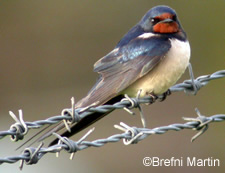
swallow willeville july 05
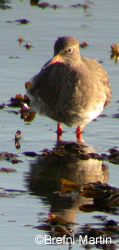
Redshank carlingford oct 04
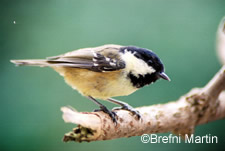
coal tit aug 04
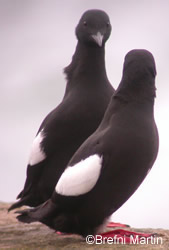
black
guillemots giles quay apr 05
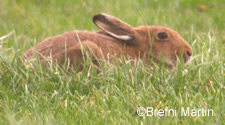
Hare willeville feb 05
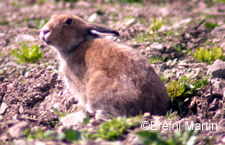
Mountain hare willeville apr 05

stonechat
whitestown aug 05

guillemots and razorbills whitestown sept 05
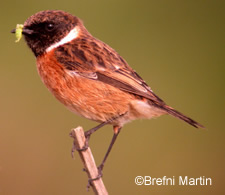
stonechat male spring wt caterpillar
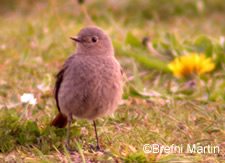
black redstart giles quay april 05
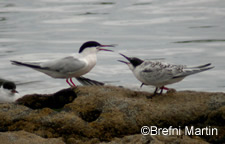
Snipe

Great Crested Grebe